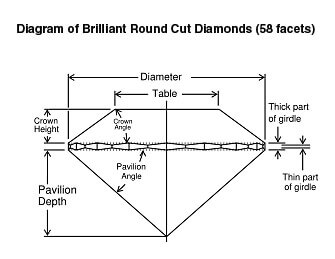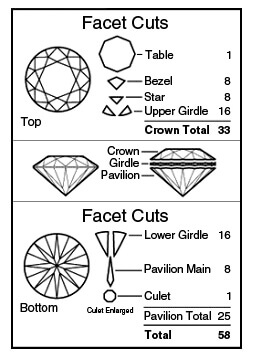Diamonds are graded according to the quality of cut, clarity, color and carat. Known as the Four Cs, these four points determine the value of a particular stone:
This Diamond Buying Guide is designed to help you understand how diamond value and quality is determined. Diamond grading standards are defined by the GIA (Gemological Institute of America). Diamond experts evaluate diamonds for rarity and beauty using four primary guidelines: cut, color, clarity and carat weight.
CutThe cut of a diamond refers to its shape and also to the proportions of how the diamond is actually cut. Diamonds can be cut into many different shapes, reflecting popular taste and also the proportions and quality of the rough stone. Popular shapes include round, oval, square, princess, emerald, baguette and marquise (navette) cuts.
A diamond's overall proportions, as well as the size and placement of its facets, greatly affect how the stone captures and reflects light. Atlantic Gems keeps most of the shapes in stock and can source any shape imaginable.


Standard Facets by Shape
| Shape | Number of Facets |
| Round Brilliant | 58 |
| Oval | 58 |
| Princess | 58 |
| Emerald | 58 |
| Marquise | 58 |
| Pear | 58 |
| Radiant | 70 |
ColorColor is considered by some to be the most important factor in selecting your diamond jewelry, because it is visible to the naked eye. With the exception of some fancy colored diamonds, the most valuable diamonds are those with the least amount of color. The color scale for transparent diamonds range from D-F (colorless), G-J (near colorless), K-M (faint yellow), N-R (very light yellow) and S-Z (light yellow). Colorless diamonds are very rare.
ClarityClarity is a measurement used to determine the number of inclusions within a diamond. Inclusions reduce the amount of light that can freely reflect through the diamond facets. Most diamond inclusions are not visible to the naked eye. Diamonds graded SI1 or SI2 have small inclusions and can appear flawless to the naked eye. True flawless diamonds are graded FL or IF and are extremely rare.





Inclusions occur inside the stone and are similar to fingerprints, a characteristic that gives us all a special signature. Getting to know your diamond makes the stone a more personal possession and will help you describe and identify the gem. Some inclusions affect the diamond's clarity, making it less brilliant because they interfere with light as it passes through the stone.
Some of the most common types of inclusions include: crystal, mineral, pinpoint and feathers inclusions. Pinpoint inclusions are tiny light or dark crystals in diamonds that appear by themselves or in clusters and large clusters of minute pinpoints can create a hazy area in the diamond. Feathers are cracks within the stone that resemble feathers. Small feathers do not usually affect a diamond's durability unless they reach the surface on the top of the stone (a location that's prone to accidental blows).
| Clarity Grade | GIA Diamond Clarity Grading Scale | |
|---|---|---|
| FL | No inclusion or surface blemishes (Flawless) | Museum Quality |
| IF | Insignificant blemishes (Internally Flawless) | Museum Quality |
| VVS1 | Extremely difficult to see at 10x (Very, Very Slight Inclusions) | Rare |
| VVS2 | Very difficult to see at 10x (Very, Very Slight Inclusions) | Rare |
| VS1 | Difficult to see face up at 10x (Very Slight Inclusions) | Rare |
| VS2 | Somewhat easy to see face up at 10x (Very Slight Inclusions) | Rare |
| SI1 | Noticeable, easy to see at 10x (Slight Inclusions) | Fine |
| SI2 | Very easy to see at 10x, may be visible to the unaided eye (Slight Inclusions) | Fine |
| I1 | Obvious at 10x, visible to the unaided eye Imperfect) | Promotional |
| I2 | Obvious at 10x, easily visible to unaided eye, beauty/durability somewhat affected (Imperfect) | Promotional |
| I3 | Prominent inclusions, extremely easy to see with unaided eye, durability affected (Imperfect) | Promotional |
The size of a diamond is measured by weight. One carat, the traditional unit of measure for diamonds, is equal to 0.2 grams and measures approximately 6.5mm wide. Diamonds of equal weight may appear slightly different in size, depending on their depth and proportions.
The term "carat" dates back to the traders of the ancient world. A standard weight was required for precious gems as merchants of the ancient Mediterranean and Middle East were dependent on the ability to trade with a reasonably consistent unit of measurement. It was this need that led to the adoption of seeds and grains as widespread units of measurement.
The carob seed and the wheat grain, both of which had been used for food purposes were found to be ideal units of weight. For centuries the carob seed remained the weight measurement for precious gems. By the Middle Ages, however, changes in the trade routes had occurred and large centers of trade were now found within Europe. The carat, as it had become known, became linked to 4 grains Troy weight, with the carob seed having been abandoned at some point during the shift of trade centers. The Troy carat was the equivalent of approximately 205 milligrams. This measurement of weight lasted for the carat until the 20th century. It was between 1907-1914 that the carat was married to the metric system of weights. By 1914 the United States officially abandoned the former Troy measurement of 205.3 milligrams for the carat, and adopted the current metric carat measurement of 200 milligrams.
Carat Conversion Chart
| mm width | Weight | Carat (CT) |
|---|---|---|
| 1.0mm | .005 CT | |
| 1.2mm | .008 CT | |
| 1.3mm | .01 CT | |
| 1.5mm | .015 CT | |
| 1.7mm | .02 CT | |
| 1.8mm | .025 CT | |
| 2.0mm | .03 CT | |
| 2.1mm | .035 CT | |
| 2.2mm | .04 CT | |
| 2.4mm | .05 CT | |
| 2.5mm | .06 CT | |
| 2.7mm | .07 CT | |
| 2.8mm | .08 CT | 1/12 CCT |
| 2.9mm | .09 CT | |
| 3.0mm | .10 CT | |
| 3.1mm | .11 CT | |
| 3.2mm | .12 CT | |
| 3.3mm | .14 CT | 1/7 CT |
| 3.4mm | .15 CT | |
| 3.5mm | .16 CT | 1/6 CT |
| 3.6mm | .17 CT |
Carat Conversion Chart
| mm width | Weight | Carat (CT) |
|---|---|---|
| 3.7mm | .18 CT | |
| 3.8mm | .20 CT | 1/5 CT |
| 3.9mm | .22 CT | |
| 4.0mm | .23 CT | |
| 4.1mm | .25 CT | 1/4 CT |
| 4.2mm | .30 CT | 1/3 CT |
| 4.4mm | .33 CT | |
| 4.5mm | .35 CT | |
| 4.6mm | .38 CT | |
| 4.8mm | .40 CT | |
| 4.9mm | .43 CT | |
| 5.0mm | .47 CT | |
| 5.2mm | .50 CT | 1/2 CT |
| 5.4mm | .60 CT | |
| 5.5mm | .63 CT | |
| 5.6mm | .65 CT | |
| 5.8mm | .75 CT | |
| 6.0mm | .80 CT | |
| 6.2mm | .85 CT | |
| 6.4mm | .95 CT | |
| 6.5mm | 1.00 CT | 1 CT |
**Please note that all information listed was collected from various sources. This information is offered as a service. Atlantic Gems, Inc. does not guarantee the validity of any of these statements.
< Back To Education